The American Buffalo, a new documentary by filmmaker Ken Burns, argues that bison and Native Americans share a common history. Today, tribes are working to heal their communities by rebuilding herds.
By Katie Scarlett Brandt
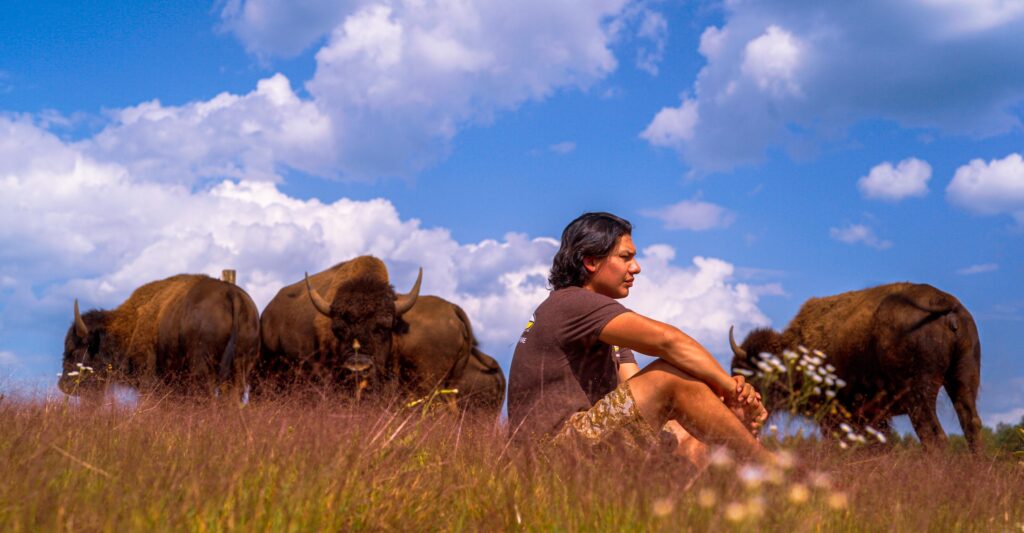
Native peoples are having a cultural moment with the release this fall of two major films. Along with Martin Scorsese’s Killers of the Flower Moon, a dramatization of the killing of the Osage people over oil found on their land, a new Ken Burns documentary — The American Buffalo — premiered on PBS. In his first biography of an animal, Burns weaves together a morality tale, connecting the near-extinction of buffalo with the devastating losses that America’s Native people experienced as a direct result.
“It was an incredibly cynical calculus that if you kill the buffalo, you’ll kill the Indian,” Burns said in an interview with Native Science Report just before the film’s October 16 release. “It’s terrifying to contemplate what happened to the Plains tribes, who were so invested in the buffalo, who were so intertwined from birth to death, in every aspect of their lives and their spiritual lives.”
But the American Buffalo also tells the story of renewal. “This is not just the story of tragedy,” said Dustin Tahmahkera, who chairs Oklahoma State University’s Department of Native American Studies and served as an advisor for the film. “It’s the story of persevering and continuing on.” Tribes are growing stronger, and finding hope in the restoration of their own buffalo herds.
Our spirit wants to be connected
This sense of renewal can be found in the forested Menominee Reservation of Wisconsin where, on an overcast Monday afternoon in early October, Donavan Waupoose was walking laps on an indoor track and talking about buffalo, specifically how they had changed his life over the past year.
Soon, dozens of people would gather in the community center where Donavan was exercising. Outside, the leaves in this north-central Wisconsin town were already fading from their peak bright colors. But the people who would soon gather for traditional games, followed by a buffalo feast and giveaway, were full of life and gratitude for what Donavan and his brother, Bryant Waupoose, had made possible.
“There’s a struggle in our communities because our spirit wants to be connected,” Bryant said.
The Waupooses, both Menominee and in their 30s, have been working to rebuild that connection. They had organized the event as a culmination of their first buffalo harvest. A year earlier, Bryant worked with the InterTribal Buffalo Council and The Nature Conservancy to bring ten buffalo to 80 acres of land near the community center.
Since then, Donavan has been caring for the herd. “Our Menominee Buffalo Initiative is striving to reconnect us to our culture and our ancestors by reviving the DNA inside of us that has been put to sleep by colonization,” he said. And that night, the brothers would feed their community with buffalo in a variety of culinary forms: chili, spaghetti, and tacos; as well as native wild rice, squash, and more. “If we do this right, our nation, our people, will never remember what it’s like to not have buffalo ever again,” Bryant said.
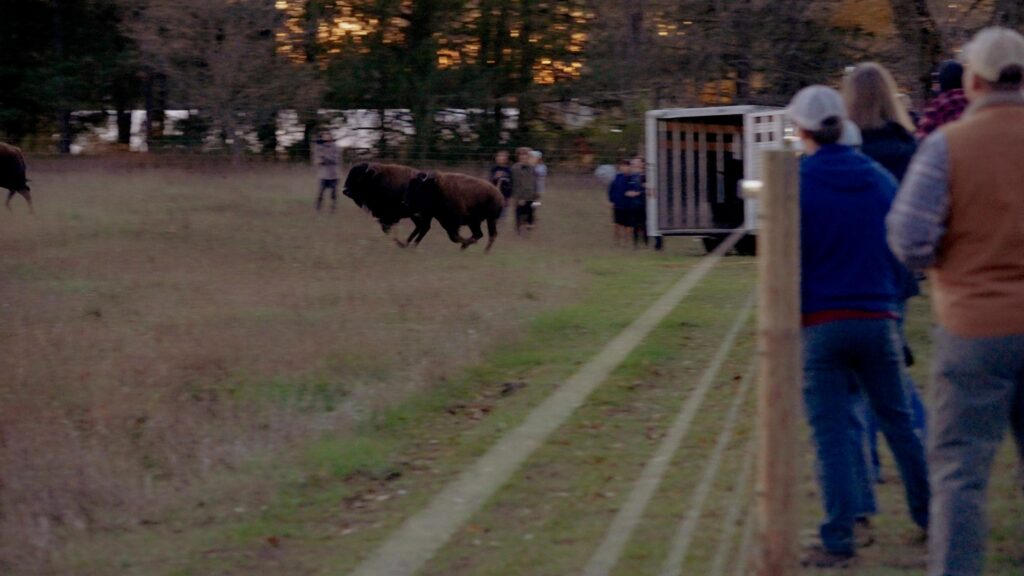
For Donavan, the buffalo are a direct channel to that healing. He recalled first meeting the buffalo, when they hesitated to approach him, until he got down on his knees.
“As soon as I dropped to my knees, they all turned and came right towards me. That was another pivotal moment in my life,” Donavan said.
And as he remembered that early meeting, he broke down in tears. Being outside, spending time with the buffalo, has been a gift to Donavan, helping him find purpose beyond himself.
“I work for the buffalo — not an organization, not anybody. That was my healing, and now all of these dreams — everything — makes sense,” Donavan said.
The Waupooses’ efforts reflect buffalo restoration projects happening throughout tribal lands, from grassroots community groups to tribal colleges. The InterTribal Buffalo Council, a collection of 80 tribes in 20 states, has connected and encouraged these efforts since 1991.
Even with their small herd of 10, the Waupooses on Menominee Reservation are integral to that repair. Through their organization Medicine Fish, they represent to their community a chance for cultural reconnection, food sovereignty, and ecological restoration.
Now it’s our turn to take care of them
Julianna Brannum, a Comanche filmmaker who served as consulting producer on The American Buffalo, featured the Waupooses’ buffalo initiative in a 20-minute short film, Homecoming, that she made to continue the story told in The American Buffalo. She said she hopes tribes see it and think about what they can do on their own land.
“I really hope that tribes are inspired to do this, even if it doesn’t have to do with buffalo. Just living on the land, off the land,” Brannum said.
Kai Teague, whose work centers on Native environmental stewardship on Fort Peck Reservation in Montana, agreed. “The Dakota and Nakoda people aren’t who they are without the buffalo, Teague said. “They took care of us, and now it’s our turn to take care of them. In doing that, both will happen.”
Native people, Teague said, are now relearning who they are in relation to buffalo. “We’re lost to some degree, but we’re trying to find our way, which is more than what at times we’ve been doing,” Teague said. “More people are conducting ceremonies, participating in sweat, and participating in sundance. It’s tied to the buffalo. I know it’s growing. We all do — we can feel it and see it happening.”
Brannum notes that even tribes not historically associated with buffalo are now establishing herds. Agriculturally-centered tribes forcibly removed from the southeast to Oklahoma, for example, “realize this is their new environment, this is where this animal used to be, so they take care of it,” she said. “I love that tribes are doing that and considering making their own herds for ecosystem and biodiversity restoration, or for food sovereignty purposes. We have to heal our health to heal our culture.”
It’s complicated
Burns remembers the first time he saw a buffalo. As a child, he visited a zoo, where he stood near eye-level with the massive animal. “There’s something about them,” Burns said, decades later. “They’re not only magnificent and odd-looking, but their eyes reflect the deep history that they’ve seen.” He likens the experience to being amongst tall trees that have watched the rise and fall of towns around them. “I understand why Native tribes can center buffalo as the beating heart of their spiritual lives.”
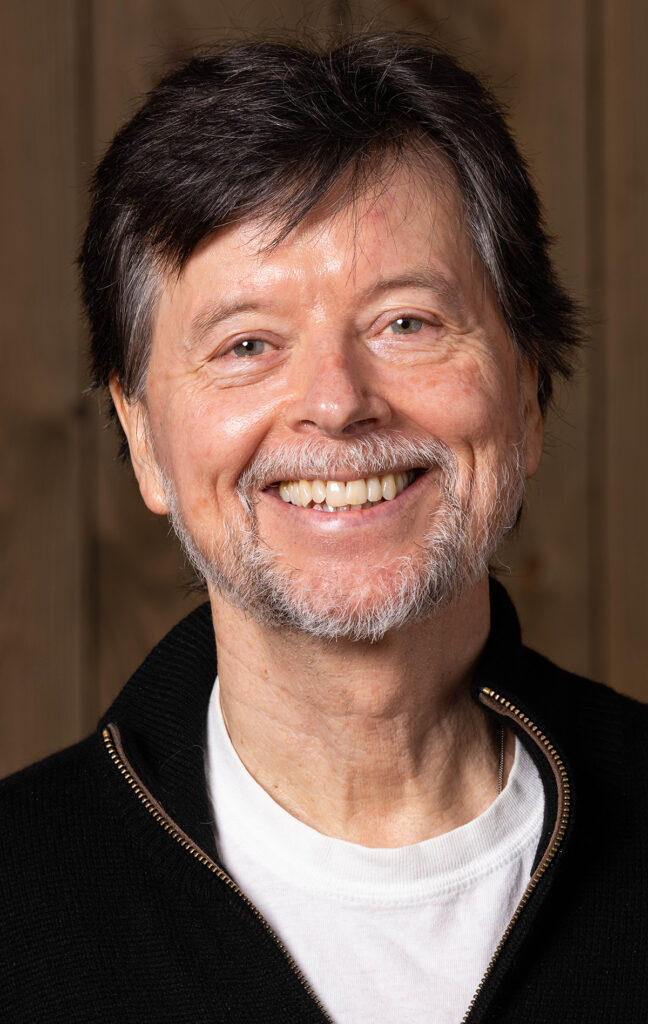
Past projects led Burns to center buffalo in his latest documentary. In his mid-1990s film The West, bison figured prominently. Subsequently, his documentaries on Lewis and Clark and the National Parks system also included buffalo.
“In fact, we came across a proposal from the mid-90s that, amidst the biographies we do of human beings, we do a biography of an animal. I’m really glad we waited,” Burns said.
Burns and his team, including consulting producer Brannum, worked on The American Buffalo for four years. Burns called the project “a great learning curve” and said he found something new every day.
Brannum spent much of that time in white cotton gloves, digging into archives at libraries all over the country. “I’ve worked as an archival producer before, but this was next level,” she said.
The team would gather under a neon sign in the editing room that said “It’s complicated.”
They reviewed cuts of the film, going line by line and checking in about how everyone was feeling and whether the information was accurate. “It’s very nitty gritty, very tedious, very fun,” Brannum said.
And with Burns’ credibility, she said the team had the privilege of time to make the film. “That time is so needed to cultivate relationships and get the storytelling and facts straight, because basically you get a mini PhD when you watch his films.”
Burns found beauty in the process, too. “You go in knowing it’s going to be complicated, but you don’t understand fully how it is,” he said. “We’ve been practicing for 50 years how to touch [this complex history], how to open it up, how to talk about what really happened. The stories that are interesting are the ones that are really complicated.”
The son of an anthropologist, Burns grew up with a map in his childhood home that showed the tribal divisions within the U.S. And working on this documentary seems to have brought those dividing lines to life for Burns.
“Everything is a process of discovery,” he said.
The people who spent decades trying to obliterate Native Americans and the buffalo then turned them into mascots, fetishizing and romanticizing them into the idea that many Americans today still have of Indigenous people.
“The buffalo reminds us of the dimensions of the tragedy,” Burns said.
Collaboration, research, education
The work has been emotional for Brannum. “My tribe has a very small herd. We may even be selling it because we don’t have enough land to maintain it. To get to that point where you can build the infrastructure, have enough grazing land for the buffalo — it’s all very challenging and expensive work.”
Much of the expense comes from purchasing land back from non-Native people, in order to turn a checkerboard of Native, non-Native, and federal land into a solid pact for buffalo to roam.
The InterTribal Buffalo Council helps tribes navigate that process. Their efforts involve some 20,000 buffalo on nearly 1 million acres. And in 2014, a dozen tribal nations solidified the work in a Buffalo Treaty, with articles focusing on conservation, culture, economics, health, and education. Every year since, more tribes in the U.S. and Canada have signed on.
Buffalo restoration efforts are taking a variety of forms. Some are coming from independent groups, such as the Wuapooses’ non-profit, Medicine Fish, or the Pté Group on Fort Peck Reservation in Montana.
Other projects are coming from the tribal colleges. Aaniiih Nakoda College and the Smithsonian Conservation Biology Institute, for example, with funding from the American Indian College Fund, brought together multiple tribal colleges in 2022 to discuss how research collaboration and education centered around buffalo might play out.
“We’re trying to figure out how to use education to uphold the Buffalo Treaty. We’re trying to understand how to be in relationship with each other beyond political boundaries and through the buffalo,” Teague said.
Brannum said it’s been an honor to work on The American Buffalo film and humbling to see the animal coming back. “It’s humbling to just be around them period. It’s always been said to us that when the buffalo return, that’s when we return to become healthy.”
People want to see us succeed
On Menominee Reservation, as Bryant Waupoose took his turn walking the track at the community center, he nodded to the trees lining the horizon on the other side of the center’s expansive windows. In addition to buffalo, he’s working on removing a local dam so that the sturgeon, which the Menominee people historically relied on, can swim freely. However, the dam removal would cost more than $1 million.
“We’re in a trauma response state here. Why would we pay $1.2 million to remove that dam?” He said, alluding to the poverty and opioid addiction rampant on the reservation. But, he added, you can’t look at the dam like that. “It’s $1.2 million for a victory. It’s this mindset of why do we continue to be submissive? Why don’t we stand up? People want to see us succeed.”
Teague acknowledged the difficulty in shifting patterns and mindsets. “When you haven’t been in relationship with something for some time, it’s intimidating to get back in relationship with it. It’s hard. It’s hard work to heal.”
Waupoose started Medicine Fish in 2021, in an effort to reach Menominee youth and reconnect them to their culture through activities such as camping and fishing.
“Our young people here were just thinking we were going fishing, but we’re fishing to restore 250 years of tribal connection,” Waupoose said. “I’m fishing now, but I’m not fishing for fish anymore. I want to build resiliency and inspiration in our people.”
Major brands such as Patagonia and The Nature Conservancy signed on, and Waupoose moved away from trying to work with the tribe, which had been taking layers of approvals and reporting to get funding.
“Right now, we launched, and one person sent a large amount directly to our bank account and said, ‘Here. Believe in what you do,’” Waupoose said. “It’s different when you work with us because there’s this [history] that has to be reconciled. You can’t be savior. You have to go into those communities and find the influential people and get behind them.”
Not only is Waupoose’s effort Indigenous-led conservation, but it hinges on tribal youth investment. “We’re doing it with these young people, not for them, so that when they grow, they have direct attachment to it all. When they start to become men, they’re looking back, and they’re like, ‘Oh man, we did that. We put those fence posts in. We took that dam out.’”
An urgent story to tell
Waupoose, who until recent years had spent his teens and 20s dodging the law and working in North Dakota oil fields, discovered a greater purpose.
“My gift is influencing people. I did it the wrong way, influencing them to do the wrong things at one time in my life. But now it’s influencing them to do something good. This is a lifetime’s journey that got us to this place. If you don’t go in grounded and with purpose, you have no idea what you want to do,” Waupoose said.
Teague spoke similarly about working with a vision. “You can give someone all the education in the world, all the money in the world, but if they don’t understand who they are, it’s like a bucket with holes. Knowledge will just keep going through. I love learning but actually have a hard time with western education as a system. But once I understood who I was, I understood the relationship to the what I was learning, for better or worse.”
Burns said he finds his purpose in history and preserving a complete picture. “You don’t do these films unless you feel passionate about them. I’m working on more projects now than I ever have in my life.” He attributes that urgency to his age but also to where broader society is in this specific historical moment. “We’re at such an existential crossroads right now — and it’s not just climate change. Even the three crises in American history [the Revolution, Civil War, and Great Depression], none of them worried about free and fair elections, peaceful transitions of power. You see the same virtue and vice, generosity and greed. But things seem pretty desperate today. The urgency comes from trying to remind people.”
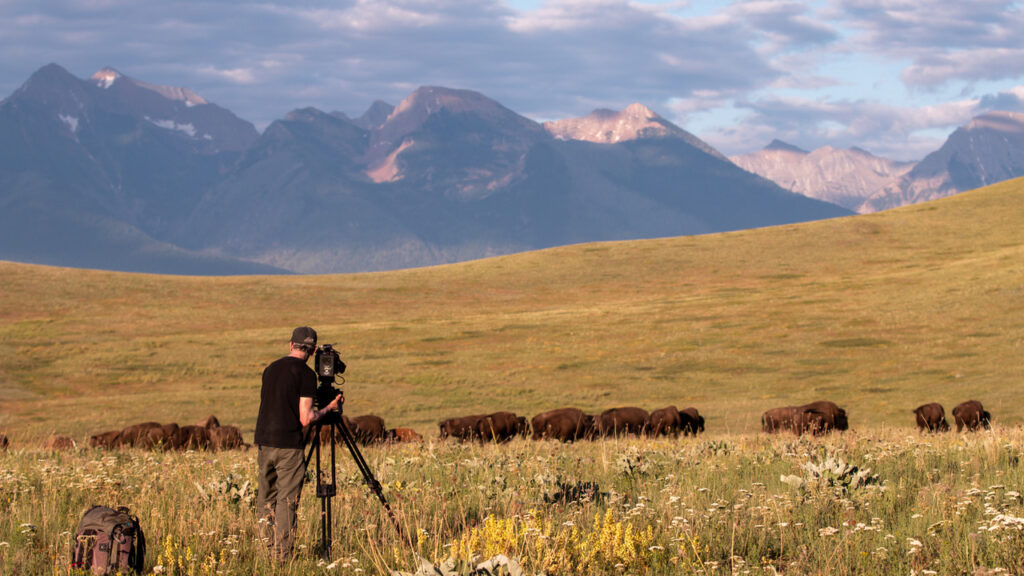
The stories in The American Buffalo serve as good teachers. “They do change you the way arguments do not. Stories permit spaces where people can slide into new forms of understanding, and that’s pretty precious. Change occurs at the edges.”
Teague is hoping for change, too.
“In my vision of the future, our families can come together. We have the things we need to have ceremony and that we of all people have access to buffalo, to our medicines — all of those things that mean we’re thriving, not surviving,” Teague said. “In that vision, the things we’re preparing, bringing, and sharing with one another, we’ve cultivated them, we’ve grown them and harvested them. We know how to do that; our kids know how to do that. We’re learning how to care for one another.”
Unlike now, Teague said, when “our communities live in trauma. It’s hard to know how to care for yourself, let alone others, when you live in trauma.”
In Teague’s hope for the future, Native people understand how to care for each other — humans and buffalo. “It sounds idealistic, but it’s not. It’s pretty simple. We need to get out of our own way.”
Bringing people together
Donavan Waupoose’s experience with the buffalo seems simple, too — especially after he spent time in prison. “I was incarcerated for two years. I was looking at 30 years to life,” he said. “I never thought I would see the light of day.”
One day, Waupoose recalled going to see a buffalo farm, one used more for farming than cultural and ecological preservation. He sat at the side of the road and started singing, as buffalo walked past him. “Then that one little one stopped, and he stared at me, and I felt this overwhelming feeling of sadness,” Donavan said. “I didn’t know what that was, but I started crying.”
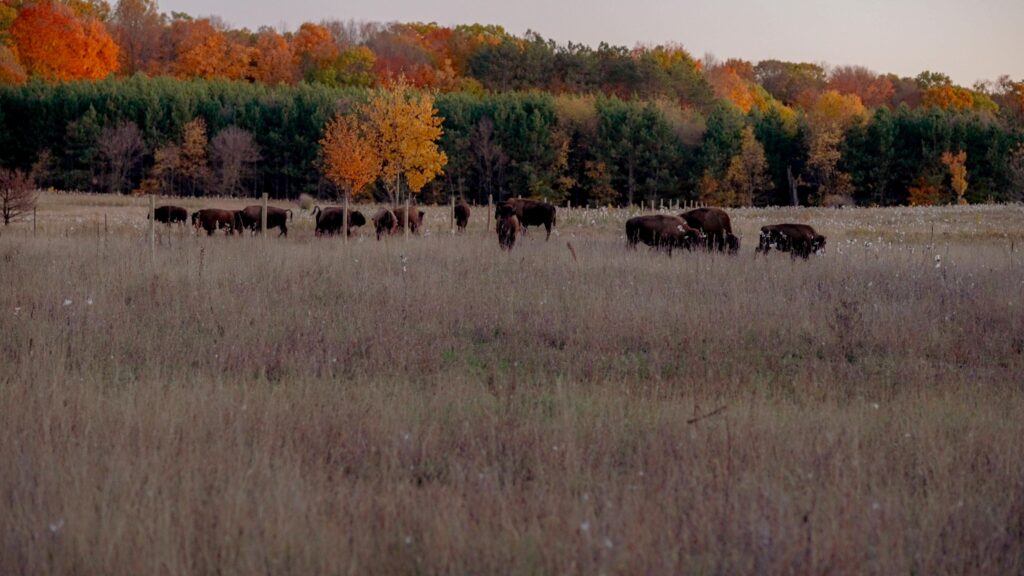
A few minutes later, he had to join a call to discuss bringing buffalo to Menominee Reservation. Donavan introduced himself and announced in that moment that he wanted to dedicate his life to the buffalo. “I got off that meeting and was driving back home, and I realized why I felt that sadness.” He saw himself in the buffalo calf, being told where to go, how to graze.
In preparing for the buffalos’ arrival, Bryant asked Donavan to come pour a slab for them. “I always say they pulled me out of that hole. Ever since then, my life has been different,” Donavan said.
Bryant understands where his brother is coming from, because he’s lived that life, too. But, he said, “We’ve got the best wellness center right outside, as soon as you leave the blacktop.”
Outside among the trees and the buffalo who, like the Waupooses, once again call the land home.
And inside the community center as the sun faded, people filled their plates with the buffalo’s offerings, prepared by Native chefs, including Chicago-based Menominee Chef Jessica Walks First. People laughed and visited with each other, hugging and catching up.
Bryant smiled. “Look at the buffalo, bringing people together.”
It’s a refrain heard all across Indian Country, Burns and his crew discovered.
“We knew that in telling the story of this animal, we’d be telling the story of the people, but we also knew we’d touch on every aspect of who we are,” Burns said.
Katie Scarlett Brandt, a freelance writer based in Chicago, is a regular contributor to Native Science Report
Story published November 16, 2023
• • •
Enjoyed this story? Enter your email to receive notifications.
